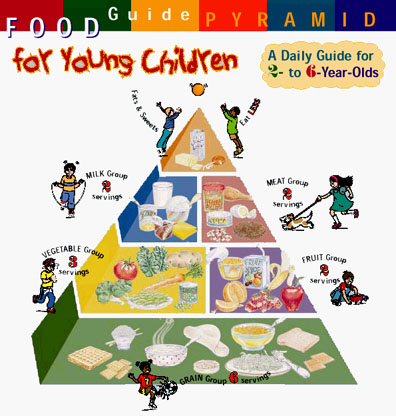
Prepared by
Beth Reames, PhD, LDN, RD,

Diane Linder, EdD, LDN, RD
and

Donna Montgomery, MS
The young child will watch family members eat and model
eating behavior after theirs. Following a healthy diet will benefit both you and
your child.
|
|
Nutrition for Young Children
Introduction
 Does your
preschool child eat only a few particular foods? Do food likes and dislikes change
frequently and without warning? Are you worried that your child is not eating
enough? Does your
preschool child eat only a few particular foods? Do food likes and dislikes change
frequently and without warning? Are you worried that your child is not eating
enough?
All of these are common concerns of parents of preschool children. During the preschool
years, a child can be taught healthy eating habits to last throughout
life. Children at this age should be exposed to many new foods. They will probably
learn to accept and even like them if the foods are presented in a relaxed and loving
atmosphere. It is also important for the parents of preschool children to practice healthy
habits. The young child will watch family members eat and model eating behavior after
theirs. Following a healthy diet will benefit both you and your child.
What You
Will Learn
In this lesson you will learn about the Dietary Guidelines for Americans and the Food
Guide Pyramid and how they apply to young children. You will learn what to expect
during each stage of the preschool years and tips to make these stages easier on both you
and your child. You will also learn about issues such as fast food, healthy weights
for young children and exercise.
Food Guide
Pyramid Review
The Food Guide Pyramid is a tool that guides us in selecting which foods to eat and how
much to eat each day to be healthy. We need a variety of foods from each of the
Pyramid categories. We should also remember to eat in moderation by eating the
recommended serving sizes. The Food Guide Pyramid is a practical guide to choosing
healthy, low-fat foods each day.
The Food Guide Pyramid for Young Children
The USDA Center for Nutrition Policy and Promotion and Department of Health and Human
Resources adapted the Food Guide Pyramid for Young Children two to six years of age. The
healthy eating messages have not changed; just the picture is new. Some of the adaptations
include foods being drawn in a realistic style. Foods shown are those commonly eaten by
two to six year of age children. Foods are in single serving portions. Food group names
are shorter. The number of servings is one number instead of a range. Two-to
three-yearolds need the same numbers of servings as four-to six-year olds, but may need
smaller size servings, about two-thirds of a serving. Two-to six-year-olds need a total of
two servings from the milk group each day. Pictures of active children were included to
emphasize the importance of physical activity. You can see the Food Guide Pyramid for
Young Children as given below.

Click here for a pdf file of the Pyramid Planning Guide to
see how your child's meals rate according to the Food Guide Pyramid recommendations.
The Dietary
Guidelines for Children
 A healthful
diet is necessary for both physical and mental development. To guide you in making
decisions about eating healthfully, the Dietary Guidelines for Americans was
developed. This provides the following recommendations for healthy Americans, ages
two years and over. A healthful
diet is necessary for both physical and mental development. To guide you in making
decisions about eating healthfully, the Dietary Guidelines for Americans was
developed. This provides the following recommendations for healthy Americans, ages
two years and over.
- 1. Offer a variety of foods. Serving a variety of foods prepared in
different ways makes meals and snacks more interesting for children and makes good
nutrition sense. Everyone needs many different nutrients for good health.
Nutrients are in food. The nutrients needed are vitamins, minerals, water,
carbohydrates, amino acids from proteins and certain fatty acids from fat. Choosing
foods from each of the Food Guide Pyramid categories will provide the variety of foods
needed for good health. These food groups are as follows: Bread, Cereal, Rice
and Pasta Group; Vegetable Group; Fruit Group; Meat, Poultry, Fish, Dry Beans, Eggs and
Nuts Group; Milk, Yogurt and Cheese Group; and the Fats, Oils and Sweets Group.
2. Serve meals that help maintain a healthy body weight. Children need
food and the calories it contains for growth and normal development. Calorie needs
of children differ because of body size, growth spurts and physical activity level.
Serving a variety of foods can help children maintain a healthy body and weight.
Serve plenty of fruits, vegetable and grain products, less fat and fewer fatty foods, and
serve sugars and sweets only in moderation. Regular physical activity is important
to maintaining good health. It burns calories, helps with weight control and is
important in preventing some chronic diseases. Experts recommend that children
engage in a minimum of 30-45 minutes of physical activity each day. There are
many types of physical activities that children enjoy at home, at school, in the community
or at childcare centers. An active lifestyle will provide the following benefits:
- Fun and relaxation
- Strong bones and muscles
- A healthy heart
- A healthy weight
- Positive attitude
- Development of motor skills, balance and coordination
- Increased energy
- Improved self-esteem
3. Offer foods low in fat, saturated fat and cholesterol. The Dietary
Guidelines for Americans suggest goals of 30 % of less of total calories from fat and less
than 10 % of calories from saturated fat for everyone over two years of age. Higher
levels of fat have been linked to obesity and certain types of cancer. Higher levels
of saturated fat have been shown to increase the risk for heart disease. At about
two years of age, children should be encouraged to choose diets that are lower in fat and
saturated fat and that provide the calories and nutrients they need for normal
growth. These goals for fats apply to the diet over several days, not to a single
meal or food.
 Lowering the fat
content lowers the calories of the meal as well. Fat contains twice the calories of
an equal amount of protein or carbohydrate. Grains, vegetables and fruits are the
best choices for adding calories when lowering the fat intake in meals. To increase
calories without adding fat, young children will probably have to eat smaller, more
frequent meals than older children or adults. Lowering the fat
content lowers the calories of the meal as well. Fat contains twice the calories of
an equal amount of protein or carbohydrate. Grains, vegetables and fruits are the
best choices for adding calories when lowering the fat intake in meals. To increase
calories without adding fat, young children will probably have to eat smaller, more
frequent meals than older children or adults.
Fats in the diet include margarine, vegetable oils, salad dressings, butter, cream and
lard. In general, foods that come from animals are higher in fat than foods that
come from plants. However, products such as lean meat, nonfat or low-fat milk and
chicken without skin have less fat than other animal products.
Most fruits, vegetables and grain products are naturally low in fat. However,
many popular items, such as french fried potatoes, croissants and sweet rolls, are
prepared with fat. All fats contain a mixture of saturated and unsaturated
fat. Saturated fats are found in the largest amounts in animal products and some
vegetable fats such as coconut, palm and palm kernel oils.
- 4. Serve plenty of vegetables, fruits and grain products. These are
generally low in fat. They are important because they are also good sources of
complex carbohydrates, dietary fiber and other substances in food linked to good health.
5. Offer and use sugars only in moderation. Sugars and many foods that
contain them in large amounts supply calories but may be limited in vitamins and
minerals. They should be used in moderation by most healthy people and sparingly by
people with low calorie needs.
Frequent between-meal snacks of foods such as cakes, chips, crackers and pastries,
candies and dried fruits may be more harmful to children's teeth than sugars eaten with
regular meals.
 6. Offer and
use salt and sodium only in moderation. Most Americans eat more salt and sodium
than they need. Some people may reduce their chances of getting high blood pressure
by eating less salt. Since there is no way to predict who will develop high blood
pressure, serving foods lower in sodium and reducing or omitting salt during food
preparation may help some children avoid high blood pressure when they become adults. 6. Offer and
use salt and sodium only in moderation. Most Americans eat more salt and sodium
than they need. Some people may reduce their chances of getting high blood pressure
by eating less salt. Since there is no way to predict who will develop high blood
pressure, serving foods lower in sodium and reducing or omitting salt during food
preparation may help some children avoid high blood pressure when they become adults.
7. Promote an alcohol and drug-free lifestyle. Children and teens
should not drink alcoholic beverages. Use of alcoholic beverages involves risks to
health and other serious problems.
 Issued in furtherance of Cooperative Extension
work, Acts of Congress of May 8 and June 30, 1914, in cooperation with the United States
Department of Agriculture. The Louisiana Cooperative Extension Service provides equal
opportunities in programs and employment. Information and Graphics on this site are
copyright protected by LSU Agricultural Center's Louisiana Issued in furtherance of Cooperative Extension
work, Acts of Congress of May 8 and June 30, 1914, in cooperation with the United States
Department of Agriculture. The Louisiana Cooperative Extension Service provides equal
opportunities in programs and employment. Information and Graphics on this site are
copyright protected by LSU Agricultural Center's Louisiana
Cooperative Extension Services.
For more information on the EFNEP program, contact EFNEPMail@agcenter.lsu.edu. |